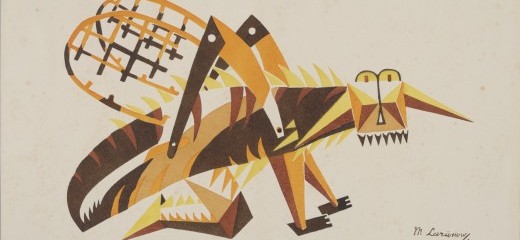
Photo: Philadelphia Museum of Art
Dance on Paper at the Philadelphia Museum of Art
by Jonathan Stein
thINKingDANCE asked a number of its writers to respond to selected works in the newly opened works on paper exhibition, Dance: Movement, Rhythm, Spectacle that will run through August 2, 2015 in the Berman Gallery of the Philadelphia Museum of Art. The show taps into the museum’s extensive collection of dance-related images in the media of prints, drawings, watercolors, and photographs from the 1890s to the 1980s, and is divided into sections reflecting social dance, dance in performance, and abstracted images from dance. Its curator, Anna Juliar, Margaret R. Mainwaring Curatorial Fellow, Dept. of Prints, Drawings and Photographs, is presenting works never or not recently seen on view at the PMA, and has included historic video that relates to work in the exhibition. In conjunction with the exhibition, Rocha Dance Theater from Brooklyn will perform in the gallery on June 24, and a Salsa Dance Social will occur on July 10.
Below are the responses of thINKingDANCE writers Lynn Brooks, Ellen Chenoweth, Patricia Graham, Kirsten Kaschock, Gregory King, Lisa Kraus, and Whitney Weinstein. All photos are courtesy of the Philadelphia Museum of Art. Links are provided where images cannot appear.
***
Sweeping Strokes: Wharton H. Esherick, Rhythms, Opening (1922)
A starburst of bodies erupt like the sun into darkness, at its center a circle of dancers. The dance is of one and of many who emerge from common origins into abounding directions. The bodies bloom: curving under, bowing down, arching back, twisting over. Like wheat grass swaying in a field, the energy is light, yet grounded, flexible, but strong. An ephemeral sequence, captured in sweeping strokes both swift and precise, weaves organic curves, offering vitality. The humble glow from braided arms and stretching figures ignites my inner power. Their circuit of durability and grace is within me, is around me, is the world.
--Whitney Weinstein
***
No Bodies Required: Alexander Calder, Score for Ballet (1942)
Alexander Calder long exploded the medium of sculpture into movement. His mini-circus, an attraction at the former East Side site of the Whitney Museum, was not just models but acts. His mobiles, including the one gracing the PMA’s East entrance hall, resemble flocks of circling birds or shaped planes of color finding ever-changing relationships. Here in two dimensions, Calder melds his fascination with movement with his oft-used visual language in a new way. In this black and white drypoint, his familiar flat shapes, like guitar picks in varied sizes, are marked as being specific colors—black, yellow, blue. The tracks or chicken scratch marks denoting their pathways look like loopy
Feuillet notation, a sculptor’s vision of dancers’ directions. This
Score for Ballet could indeed be a dance, enacted, but with no bodies required.
--Lisa Kraus
***
 Fiddling Insect: Mikhail Larionov, The Cricket, Mechanical Costume for Histoires Naturelles (1916)
Fiddling Insect: Mikhail Larionov, The Cricket, Mechanical Costume for Histoires Naturelles (1916)
“Was he a beast if music could move him so?” –Franz Kafka’s “The Metamorphosis”
Mikhail Larionov’s color stencil print
The Cricket for the Ballets Russes production
Histoires Naturelles (Natural Histories) betrays the human form beneath rhythmic blocks of color. As Gregor Samsa fought his transformation into a giant insect in Kafka’s modernist fable, so the grounded knees and large abdomen of this stylized figure differ just enough from machine/insect that the image doubles as a piece of energetic whimsy and as a metaphor for the at-times drone-like experience of 20
th (and now 21
st) century humanity. That the print is also a costume design only heightens the idea of doubling, of
mechanistic reproduction—the idea that people, much like the things we build, can be replaced. That the part we play (be it fiddling cricket or plaguing locust) is the thing that matters.
Was the dancer who wore this costume recognizable as him/herself? To him/herself? Is the sublimation of the individual ever something other than a Kafkaesque nightmare? In the Age of the Selfie, it is difficult to remember that the loss of the ego in performance was once a common aesthetic goal.
--Kirsten Kaschock
***
With his face turned away from Barbara Morgan’s lens, you can’t tell his age, although the leap he is caught in is not that of an old man. Merce is only 22 or 23 at this moment of ascension, a long and productive life ahead. The jump is captured from an
extraordinary sequence in which the dancer goes from kneeling on the ground to suddenly up in the air, and then just as suddenly kneeling again, a virtuoso game of leapfrog with one person playing both roles.
A group of schoolchildren on a field trip to the museum thinks that Merce looks like Michael Jackson. Do they sense some cosmic connection, with Michael passing away in 2009 only a month before Merce? Is it the figure’s androgyny? The sense of supplication to the skies above? Both could lay a claim to representing American totem ancestors, one a king of pop representing the devastations of celebrity culture, the other laconic avant-garde royalty.
--Ellen Chenoweth
***

The Power of the Gaze: Reginald Marsh, Gaiety Burlesk (1929)
The work of American painter Reginald Marsh (1894 – 1954) was representative of life in New York in the ‘20s and ‘30s. His paintings of that time vividly captured characteristics of life in the city, reflective of the seedier side of city life. He often found his subjects in the streets, bars, and burlesque parlors.
In his etching Gaiety Burlesk (1929), women garnish the stage with their shapely bounty, approaching the viewer nonchalantly and flirtatiously. Both the performers and the audience share the role of viewer, and each watches with judgment.
Males gaze, allowing their lustful looks to linger.
Females gaze, welcoming the looks of lust – only on their terms.
The voluptuous architectural details of the room mirror the physical presence of the performers, while the teased and the teaser both assert their positions of power.
--Gregory King
***
Weddings and Consummations:
Natalia Sergeyevna Goncharova, Les Noces (1915); Joan Miró, Danse Nuptiale (1963); John Sloan, Man, Wife, and Child (1905)
Dance, weddings and marriages: What could be more familiar than these associations?

A curtain design* by Natalia Sergeyevna Goncharova (1881-1962) for the
ballet Les Noces (The Wedding) proved as ill-fated as, I expect, was the marriage the ballet depicts. In the ballet, Nijinska’s movement and Stravinsky’s music depict the grimmest, least joyful wedding imaginable: no smiles grace the faces of any relatives or friends, let alone the doomed-looking bride and groom; the angular, symmetrical dance and music patterns create walls closing in on the nuptial couple, and the color scheme of the costumes and set is dominated by brown and black. Apparently unaware of this conception, Goncharova initially designed a stage curtain of brilliant hues, dominated by orange, pink, and red, with splashes of green, blue, earthy brown, and white. Its imagery, beautifully depicted in opaque watercolor, is of florescence: a tree sprouting leaves, flowers, angels, and doves surrounded by wheeled carriages and lively peasant figures. Not surprisingly, Goncharova’s celebratory curtain design was later scrapped for a plain brown swath. The long-gestating ballet premiered in 1923.

Once a couple is wed, the marriage must be consummated. This we see in Joan Miró’s Danse Nuptiale (Wedding Dance). The abstract color lithograph of this surrealist features a long, variously thick and angled black line reaching across a white space marked by stars (or are they spiders?), to pierce the deep-red core of an embracing three-sided square topped by a black blob. Nature, heaven and earth meet in this dance of snaky, fiery union.

What follows the consummation? A home, a life, love, and progeny. John Sloan’s 1905 etching, Man, Wife, and Child, brings us into that home as seen by the artist through a window from his own residence: a man and woman—his suspenders dropping off his shoulders, her chest pressed to his—dance with abandon as a delighted ragamuffin looks on, while a bed is visible in the back room where, perhaps, this child was conceived. We know where dancing leads, after all. This image, too, has its dark undertones; its passionate drive toward life, despite the straitened circumstances of the family depicted, is exciting, but so risqué for its time that it was rejected from an exhibition for fear of its vulgarity. Yes, they too knew where dancing leads.
--Lynn Matluck Brooks
* The information that accompanies this image from the rich Ballets Russes era gives no credit for the choreography, which was by Bronislava Nijinska—indeed, the choreographers are not listed for any of the ballet works for which designs are included in this exhibit. Nor is credit given for any work’s music, which, in the case of Les Noces, was by Igor Stravinsky.
***
.jpg) Just Passin’ Thru: Alfred Bendiner, Tap Dancer (1932)
Just Passin’ Thru: Alfred Bendiner, Tap Dancer (1932)
I see you, Tap Man…
Dynamic complexity from rounded haunch to slender toe… elongated arm going and gone, as
Top Hat balances on single finger—
Rollin’ out your showmanship, your artistry… inspiring another artist.
Who are you? A remnant King of the Vaudeville and Chitlin’ circuits?
He drew you a certain way. Not an exact way you would be in space but a suggestive way, a
stylish, stylin’ way. You pop forward to us on a red canvas.
Orchestrating the night in evening dress.
Spindly wrists and ankles decorate your solid presence. Tuxedo black skin and a face of layered
consciousness.
You are about to en-ter-tain me, are you not, Tap Man?
Mystery abides in you.
And I AM entertained. I am filled with wonder at the tappity-tap of your rhyming. I am delighted
by your impossible hat trick, your floaty sleight of hand.
Howdy do… just passin’ thru.
You make it look easy.
Rendered in line and color for all to see, you remain elusive. We don’t know you, just your top
hat trick and we think we’re best friends.
Is the most delicate artistry the deepest illusion?
--Patricia Graham
***
Philadelphia Museum of Art, Dance: Movement, Rhythms, Spectacle, May 9—August 2, pay as you wish first Sundays of month and Wednesdays after 5,
www.philamuseum.org
By Jonathan Stein
June 7, 2015


.jpg)





.jpg)

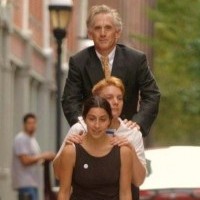
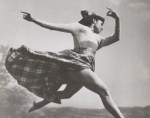
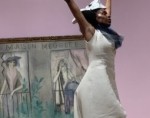
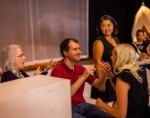
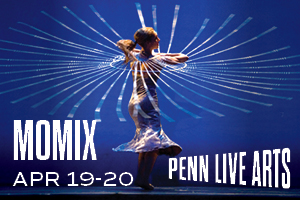
.png)


